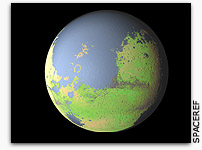Asteroids and Comets May Have Caused Rain on Ancient Mars
 Scientists from NASA and the University of Colorado suggest the bombardment of comets and asteroids on early Mars caused cycles of rain that led to global flooding and the formation of Mars’ river valleys and other water-sculpted landscapes.
Scientists from NASA and the University of Colorado suggest the bombardment of comets and asteroids on early Mars caused cycles of rain that led to global flooding and the formation of Mars’ river valleys and other water-sculpted landscapes.
The researchers emphasize that the period when large comets and asteroids struck Mars appears to correlate with the formation of ancient rivers when water once flowed on Mars, and that both ‘events’ seem to have ended about the same time, between 3.5 billion and 3.8 billion years ago. The research will be published on Dec. 6 in Science magazine in an article entitled “Environmental Effects of Large Impacts on Mars.”
“The river valleys and large craters on Mars may both be about the same age geologically,” said Teresa Segura, the paper’s lead author. “We think that the two must be related, and our paper describes one possible connection.” Segura, a graduate student in atmospheric and oceanic sciences at the University of Colorado, is based at NASA Ames Research Center, in California’s Silicon Valley.
The researchers modeled the impacts of asteroids and comets between 60 miles and 150 miles in diameter that bombarded Mars billions of years ago. Such impact events packed a huge energy wallop, equal to about 10,000 million megatons of TNT depending on collision velocities, which were lower back then.
The impacts released water on Mars in four ways, the scientists say – from the vaporized asteroid or comet itself, from Mars’ icy polar caps, from the ground where the crater formed and from the heat from hot ‘ejecta’ (a mixture of soil, rocks and water) that gradually baked water out of the martian soil.
When Mars eventually cooled down after an impact episode, scientists theorize, water that had evaporated into the atmosphere condensed into rain. During Mars’ rainy periods, precipitation rates probably averaged between 1 meter and 2 meters a year, similar to Earth’s average annual rainfall today.
“This happened dozens of times, maybe more, but after it rained, Mars would go dry,” said Dr. Kevin Zahnle, a co-author from NASA Ames. “In the times between impacts, the water sank back into the soil, where it lay dormant until the next time an impact occurred.”
Scientists think the martian rains lasted for episodes ranging from months to decades and that, between bombardments, Mars returned to its typical cold, dry state. Besides bringing moisture, the impacts also caused Mars to warm up, they say. During bombardment episodes, hot ‘ejecta’ from impacts kept Mars’ surface warm for hundreds of years at a time.
The martian cratering record shows that there are at least 30 craters carved by impactors that are 100 kilometers or more in diameter. These were created during the planet’s period of heavy bombardment by comets and asteroids more than 3.5 billion years ago.
Scientists do not know why a late heavy bombardment stopped about 3.5 billion years ago, according to Segura. “Our research provides some insight into what early Mars might have been like, but we’ve fit only a couple of pieces into the puzzle of Mars’ past,” Segura said.
Team members include Dr. Owen B. Toon, University of Colorado, and Dr. Anthony Colaprete, NASA Ames.
The project is funded by the University of Colorado Center for Astrobiology in Boulder, and the NASA Astrobiology Institute (NAI) through NASA Ames Research Center. The NAI is an international research consortium with its central offices located at NASA Ames.








